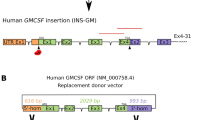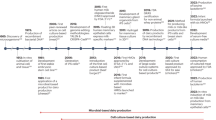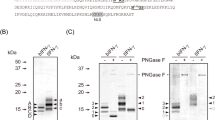Abstract
We have examined the suitability of the mouse mammary gland for expression of novel recombinant procollagens that can be used for biomedical applications. We generated transgenic mouse lines containing cDNA constructs encoding recombinant procollagen, along with the α and β subunits of prolyl 4-hydroxylase, an enzyme that modifies the collagen into a form that is stable at body temperature. The lines expressed relatively high levels (50–200 μg/ml) of recombinant procollagen in milk. As engineered, the recombinant procollagen was shortened and consisted of a proα2(I) chain capable of forming a triple-helical homotrimer not normally found in nature. Analysis of the product demonstrated that (1) the proα chains formed disulphide-linked trimers, (2) the trimers contained a thermostable triple-helical domain, (3) the N-propeptides were aligned correctly, and (4) the expressed procollagen was not proteolytically processed to collagen in milk.
This is a preview of subscription content, access via your institution
Access options
Subscribe to this journal
Receive 12 print issues and online access
$209.00 per year
only $17.42 per issue
Buy this article
- Purchase on Springer Link
- Instant access to full article PDF
Prices may be subject to local taxes which are calculated during checkout






Similar content being viewed by others
References
Kadler, K.E. Extracellular matrix 1: fibril-forming collagens. Protein Profile 2, 491–619 ( 1995).
Prockop, D.J. & Kivirikko, K.I. Collagens: molecular biology, diseases and potential for therapy. Ann. Rev. Biochem. 64, 403–434 (1995).
Kivirikko, K.I., Myllyla, R. & Pihlajaniemi, T. in Post-translational Modifications of Proteins (eds Harding, J.J. & Crabbe, M.J.C) 1–51 (CRC Press, Boca Raton, FL, 1992).
Berg, R.A. & Prockop, D.J. The thermal transition of a non-hydroxylated form of collagen. Evidence for a role for hydroxyproline in stabilising the triple helix of collagen. Biochem. Biophys. Res. Commun. 52, 115–120 (1973).
Vuorela, A., Myllyharju, J., Nissi, R., Pihlajaniemi, T. & Kivirikko, K.I. Assembly of human prolyl 4-hydroxylase and type III collagen in the yeast Pichia pastoris: formation of a stable enzyme tetramer requires co-expression with collagen and assembly of a stable collagen requires co-expression with prolyl 4-hydroxylase. EMBO J. 16, 6702–6712 ( 1997).
Fertala, A. et al. Synthesis of recombinant human procollagen II in a stably transfected tumour cell line (HT1080). Biochem. J. 298, 31– 37 (1994).
Fichard, A., Tillet, E., Delacoux, F., Garrone, R. & Ruggiero, F. Human recombinant α1(V) collagen chain—homotrimeric assembly and subsequent processing. J. Biol. Chem. 272, 30083–30087 (1997).
Arnold, W.V. et al. A cDNA cassette system for the synthesis of recombinant procollagens. Variants of procollagen II lacking a D-period are secreted as triple-helical monomers. Matrix Biol. 16, 105– 116 (1997).
Vuori, K., Pihlajaniemi, T., Marttila, M. & Kivirikko, K.I. Characterization of the human prolyl 4-hydroxylase tetramer and its multifunctional protein disulphide isomerase subunit synthesized in a baculovirus expression system. Proc. Natl. Acad. Sci. USA 89, 7467 –7470 (1992).
Lamberg, A. et al. Characterization of human type III collagen expressed in a baculovirus system—production of a protein with a stable triple helix requires coexpression with the two types of recombinant prolyl 4-hydroxylase subunit. J. Biol. Chem. 271, 11988–11995 (1996).
Colman, A. Production of therapeutic proteins in the milk of transgenic livestock. Biochemical Society Symp. 63, 141– 147 (1998).
Carver, A.S. et al. Transgenic livestock as bioreactors—stable expression of human alpha-1-antitrypsin by a flock of sheep. Bio/Technology 11, 1263–1270 (1993).
Prunkard, D. et al. High level expression of recombinant human fibrinogen in the milk of transgenic mice. Nat. Biotechnol. 14, 867–871 (1996).
Yarus, S. et al. Secretion of unprocessed human surfactant protein B in milk of transgenic mice. Transgenic Res. 6, 51– 57 (1997).
Stromqvist, M. et al. Recombinant human extracellular superoxide dismutase produced in milk of transgenic rabbits. Transgenic Res. 6, 271–278 (1997).
Paleyanda, R.K. et al. Transgenic pigs produce functional human factor VIII in milk. Nat. Biotechnol. 15, 971– 975 (1997).
Van-Cott, K.E. et al. Affinity purification of biologically active and inactive forms of recombinant human protein C produced in porcine mammary gland. J Mol Recognit. 9, 407–414 (1996).
Schnieke, A.E. et al. 1997. Human factor IX transgenic sheep produced by transfer of nuclei from transfected fetal fibroblasts. Science 278, 2130–2133.
Lees, J.F., Tasab, M. & Bulleid, N.J. Identification of the molecular recognition sequence which determines the type-specific assembly of procollagen. EMBO J. 16, 908–916 ( 1997).
Bruckner, P. & Prockop, D.J. Proteolytic enzymes as probes for the triple-helical conformation of procollagen. Anal. Biochem. 110, 360–368 ( 1981).
Berg, R.A. & Prockop, D.J. The thermal transition of a non-hydroxylated form of collagen. Evidence for a role for hydroxyproline in stabilizing the triple-helix of collagen. Biochem. Biophys. Res. Commun. 52, 115–119 (1973).
Bulleid, N.J., Wilson, R. & Lees, J.F. Type III procollagen assembly in semi-intact cells: chain association, nucleation and triple-helix folding do not require formation of inter-chain disulphide bonds but triple-helix nucleation does require hydroxylation. Biochem J. 317, 195–202 (1996).
Dombrowski, K.E. & Prockop, D.J. Cleavage of type-I and type-II procollagens by type-I/II procollagen N-proteinase—correlation of kinetic constants with the predicted conformations of procollagen substrates. J Biol. Chem. 263, 16545– 16552 (1998).
Toman, D. et al. Production of human type I procollagen homotrimers in transgenic mouse milk, pV-14 in Meeting Abstracts of the Sixth International Conference on the Molecular Biology and Pathology of the Matrix (Jefferson Institute of Molecular Medicine, Philadelphia, PA, June 16–19, 1996).
Myllyharju, J. et al. Expression of wild-type and modified proα chains of human type I procollagen in insect cells leads to the formation of stable [α1(I)] 2.α2(I) collagen heterotrimers and [α1(I)]3 homotrimers but not [α2(I)]3 homotrimers. J. Biol. Chem. 272, 21824–21830 (1997).
Lees, J.F. & Bulleid, N.J. The role of cysteine residues in the folding and association of the COOH-terminal propeptide of types I and II procollagen. J. Biol. Chem. 269, 24354–24360 (1994).
Horton, R.M. in Methods in Molecular Biology 15, PCR Protocols:Current Methods and Applications (ed White, B.A.) 251–262 (Humana Press,Totowa, NJ, 1993).
John, D.C.A., Grant, M.E. & Bulleid, N.J. Cell-free synthesis and assembly of prolyl 4-hydroxylase; the role of the β-subunit (PDI) in preventing misfolding and aggregation of the α-subunit. EMBO J. 12, 1587 –1595 (1993).
Sambrook, J., Fritsch, E.F. & Maniatis, T. Molecular cloning: a laboratory manual 2nd edn (Cold Spring Harbor Press, New York, 1989).
Miller, E.J. & Rhodes, R.K. Preparation and characterisation of different types of collagen. Methods Enzymol. 82 , 33–64 (1982).
Terlink, T., Tavenier, P. & Netelenbos, J.C. Selective determination of hydroxyproline in urine by high-performance liquid chromatography using pre-column derivatisation. Clinica Chim Acta 183, 309– 316 (1989).
Kivirikko, K.I., Laitenen, O. & Prockop, D.J. Modifications of a specific assay for hydroxyproline in urine. Anal. Biochem. 19, 249– 255 (1967).
Acknowledgements
The authors wish to thank Yvonne Gibson and the PPL small animal unit for the production of transgenic mice. K.E.K. is a recipient of a Senior Research Fellowship from the Wellcome Trust (019512). N.J.B. is a recipient of a Senior Research Fellowship from the Royal Society. An MRC-LINK cell engineering grant (G9623358) generously supported the work.
Author information
Authors and Affiliations
Corresponding author
Rights and permissions
About this article
Cite this article
John, D., Watson, R., Kind, A. et al. Expression of an engineered form of recombinant procollagen in mouse milk. Nat Biotechnol 17, 385–389 (1999). https://doi.org/10.1038/7945
Received:
Accepted:
Issue Date:
DOI: https://doi.org/10.1038/7945
This article is cited by
-
Comparative genomic and biochemical analyses identify a collagen galactosylhydroxylysyl glucosyltransferase from Acanthamoeba polyphaga mimivirus
Scientific Reports (2022)
-
Development and characterization of a eukaryotic expression system for human type II procollagen
BMC Biotechnology (2015)
-
Collagens as biomaterials
Journal of Materials Science: Materials in Medicine (2009)
-
Prolyl 4-hydroxylation regulates Argonaute 2 stability
Nature (2008)
-
Assessment of prokaryotic collagen-like sequences derived from streptococcal Scl1 and Scl2 proteins as a source of recombinant GXY polymers
Applied Microbiology and Biotechnology (2006)



